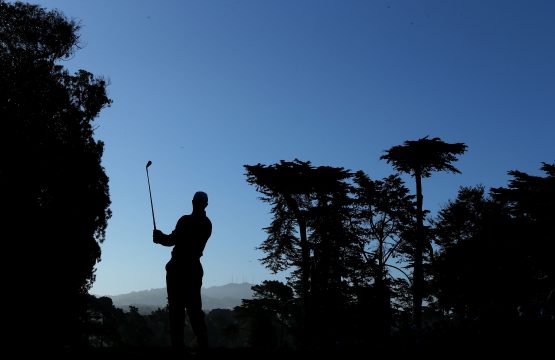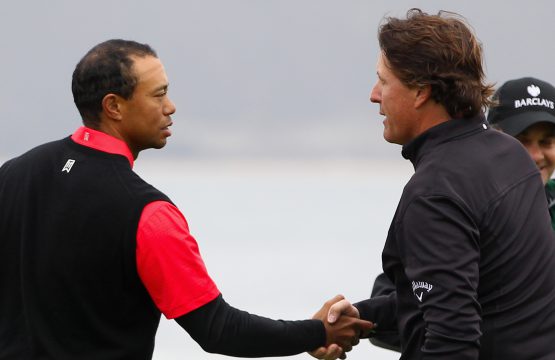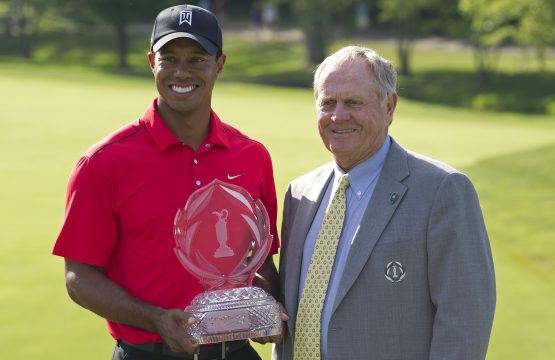Crowds turn out for Woods’ practice round with Martin
SAN FRANCISCO — Tiger Woods usually draws a crowd, and that was the case Tuesday at the Olympic Club, site of this week’s 112th U.S. Open.
A large contingent of early-bird fans watched Woods play a morning practice round with former Stanford teammate Casey Martin and current Cardinal golfer Cameron Wilson. A standing-room-only crowd that included 16 television cameras and more than a dozen still photographers jammed the interview room in the USGA media tent for Tiger’s pre-tournament press conference.
Before addressing the media, Woods gave a hearty hug to Billy Casper, who won the 1966 U.S. Open at Olympic, besting Arnold Palmer in a playoff. Many, including Woods, consider Casper one of the most unappreciated golfers of all time.
“He won 50-plus events, three major championships, that’s not that big an upset,” Woods said of Casper’s win at Olympic. “He’s a hell of a player.”
While many consider the 36-year-old Woods the favorite this week, underdogs have prevailed in four previous U.S. Opens at Olympic. In 1955, Jack Fleck beat Ben Hogan; Casper edged Palmer; in 1987, Scott Simpson defeated Tom Watson; and in 1998, Lee Janzen bettered Payne Stewart.
“If you look at all those golfers, they all shaped the ball,” said Woods. “And I think they’re proficient at going either way with the golf ball.”
Contenders this week will need to do both. Almost every hole is lined with trees on each side, and there are seven doglegs. The farther you hit the ball off the tee, the more likely you are to find nasty rough, especially with the firmness of the fairways.
“It’s quick out there,” said Woods, a three-time U.S. Open champion who is gunning for his 15th major championship. “It’s getting up to speed. I’m sure that it will get quicker as the week goes on. But it’s going to be a wonderful test.”
Woods did not play in last year’s U.S. Open at Congressional Country Club due to injury. He did compete in the ’98 U.S. Open at Olympic, tying for 18th. What does he remember?
“Frustrated,” Woods said. “Just like you are at most U.S. Opens. I was right in the middle of changing my game. And it was just a frustrating time going through that, and playing this venue during that time was not easy.”
Woods believes the U.S. Open is the toughest major to win.
“I think this probably tests the player more than any other championship,” he said. “We have to shape the ball. We have to hit the ball high. We have to hit the ball low. Our short game’s got to be dialed in.
“The only thing that’s different with U.S. Opens in the past it was always, miss the green, automatic lob wedge. Now with some of these runoff areas, we can play bump-and-runs, we can play skips shots, we could flop it if we wanted to. We have different options.”
Woods has always preferred fast, difficult courses and should get his wish this week. While he might have a mini-advantage, having played Olympic many times while attending nearby Stanford University, the layout has been lengthened and toughened since 1998. That’s the case with the first six holes in particular.
“If you can play them four straight days even par, you’re going to be picking up just a boatload of shots,” Woods said.
Tiger will play the first two rounds with Phil Mickelson and Bubba Watson and doesn’t expect much conversation. Nothing personal.
“I don’t’ think we’re going to talk about a lot,” he said. “This is a major championship. We’ve got work to do.
“It’s such a test playing in this championship. I think this is one of those championships that I think the guys talk the least to one another because it so difficult. There’s no shot you can take off.”
There was plenty of chatter Tuesday, however, between Woods and Martin. The duo were occasional roommates on Stanford golf trips in 1995.
“Man, it’s great to see him,” Woods said of Martin, the golf coach at the University of Oregon. “And just so happy in life. It’s good to see him in a really good place.”
Martin suffers from a rare circulatory ailment in his right leg called Klippel-Trenaunay-Weber Syndrome, a birth defect that limits blood flow. He sued the PGA Tour for the right to ride in a golf cart and won, tying for 23rd in the 1998 U.S. Open at Olympic.
Although he plays sparingly these days, he surprised himself by earning a return trip to Olympic last week in 36-hole sectional qualifying in Oregon.
“Unless you really know him, I don’t think people have an appreciation of how much pain he’s in,” said Woods. “Just the everyday pain he lives with. He doesn’t show it, doesn’t talk about it, doesn’t complain, he just lives with it.
“And you just look at him and he’s always so happy. It’s very easy to go the other way and be very bitter, because of how uncomfortable he is on a daily basis. But I think that’s what makes him special. That’s what makes him so different than everyone else — he has such a strong will and such a strong spirit.”
Tiger tees off Thursday at 10:33 a.m. ET on the ninth tee with Mickelson and Watson. On Friday, the trio starts on the first tee at 4:29 p.m.


